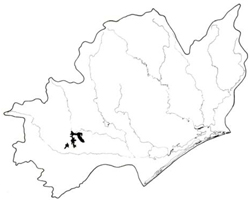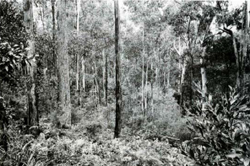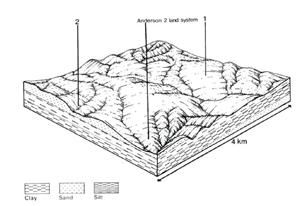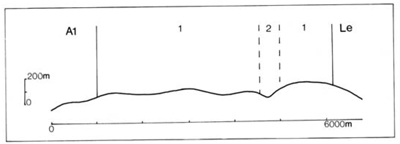Boola (Bo)
 | Area: 77 sq. km (0.4%) Some areas of Tertiary deposits have been uplifted by movements associated with the Yallourn Monocline. Relatively undissected, gently undulating remnants of the former Tertiary surface at these higher elevations are mapped in Boola land system. Tertiary deposits tilted along the Monocline have been more dissected to form hilly topography and these are mapped in Anderson 2 land system. Deeply-dissected. steep, mountainous areas on the uplifted Tertiary sediments are in Haunted Hills land system. The moderate to high rainfall and extensive weathering of the Tertiary sediments have produced highly-developed horizons that are strongly leached and often moderately to strongly acidic. Variation does occur according to changes in parent material. On deep sandy deposits, grey, bleached topsoils are underlain by coffee-rock horizons. Where the parent material contains sufficient clay, yellow duplex soils with medium blocky-structured, clay sub-soils appear to dominate, although yellow, gradational soils with fine granular-structured subsoils were also observed. Sheet erosion is a hazard where sandy topsoils overlie less permeable materials at relatively shallow depth. The vegetation is mainly open forest II with open forest III on lower slopes. |  Shrubby open forest growing on a mid-slope of moderate gradient |
| CLIMATE Rainfall, mean (mm) Temperature, mean (°C) Seasonal growth limitations |
Annual 700 - 1200; lowest January or February (40 - 70). highest August or October (90 - 120) Annual 12 - 14: lowest July (8 - 10), highest February (19 - 21) Temperature <10°C (av.): May - September Rainfall < potential evapotranspiration: November – March |
| GEOLOGY Age, lithology |
Tertiary outwash fan deposits; unconsolidated gravels. sands and clays |
| PHYSIOGRAPHY Landscape Elevation range (m) Relative relief (m) Drainage pattern Drainage density (km/km2) |
Gently undulating to hilly terrain 180 - 400 60 - l60 Dendritic 0.9 |
| PRESENT LAND USE |
Minor proportion cleared: grazing of beef and dairy cattle and fat lambs, mainly on improved pastures: softwood plantations (limited) |
 |  |
| LAND COMPONENT Percentage of land system Diagnostic features | 1 80 Flat plains to moderate slopes | 2 20 Steep slopes |
| PHYSIOGRAPHY Slope %, typical and (range) Slope shape | Plains: 3 - 5. (0 - 10): slopes: 15 - 20. (10 - 25) Convex to concave | 30 - 35. (20 - 40) Straight |
| SOIL | ||
| Parent Material | Variable: clay, silt, sand and gravel | |
| Description | Few observations — deep sand deposits: thick light grey sandy topsoil over hard brown cemented sand (coffee rock) overlying yellow sand. Other areas: probably predominantly greyish brown sand to clay loam topsoil over mottled yellowish brown blocky acidic clay subsoil: some finely structured yellowish brown acidic sandy clay loam or clay loam | |
| Classification | Uc2.34, Uc2.36, Dy3.12, Dy3.21, Gn4.81, Gn4.51 | |
| Surface texture | Very variable: sand to clay loam | |
| Surface consistence | Variable depending on texture | |
| Depth (m) | <2.0 | |
| Nutrient status | Very low for sandy soils; low to moderate elsewhere | |
| Available soil water capacity | Very low for sandy soils: low to moderate elsewhere | |
| Perviousness to water | Rapid on sands: slow to moderate elsewhere | |
| Drainage | Good | |
| Exposed stone | 0 | |
| Sampled profile number | - | |
| NATIVE VEGETATION Structure of vegetation and characteristic species of dominant stratum (+ Predominant species) | Open forest II. often shrubby: Mostly mixed forests with species including E. consideniana+, E. muellerana+, E. sieberi+ (upper slopes). E. dives and E. globoidea | Limited data — probably open forest III with species including E. Cypellocarpa. E. muellerana, E. obliqua and E. sieberi. E. radiata (presumed) |
Disturbance | Affected process and trend | Primary resultant deterioration | Casual activities | Primary off-site process | ||
Form | Susceptibility of components | Incidence with components | ||||
— reduction in leaf area, rooting depth and/or perenniality |
|
|
2; low |
|
|
|
|
|
|
2; moderate |
|
|
|
|
with reduced infiltration |
Sheet and rill erosion |
1; low 2: moderate |
|
As for sheet and rill erosion above |
Increased flash flows |
|
|
|
2; moderate |
|
|
|
| Comments: No observations of deterioration | ||||||


